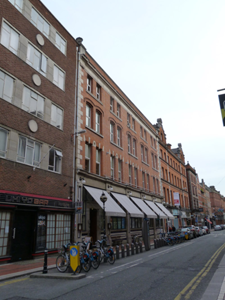Survey Data
Reg No
50910215
Rating
Regional
Categories of Special Interest
Architectural, Artistic
Previous Name
Telephone Exchange
Original Use
Shop/retail outlet
Historical Use
Telephone exchange
In Use As
Shop/retail outlet
Date
1895 - 1905
Coordinates
315722, 233924
Date Recorded
26/10/2015
Date Updated
--/--/--
Description
Attached five-bay four-storey former commercial building, built 1899-1900, with paired windows to each bay. Now in use as restaurant and retail outlet. Hipped roof, hidden behind brick parapet, with moulded Portland limestone coping having Portland limestone piers and urn finials to ends, and cast-iron rainwater goods to west end. Carved Portland limestone cornice over red brick walls, laid in Flemish bond, with limestone quoins to ends of facade. Square-headed window openings to first and top floors, first floor having bull-nosed brick reveals and voussoirs, carved Portland limestone keystone and sill course, top floor having moulded sills, and camber-arch openings to second floor having stepped brick reveals, Portland limestone sills, red brick hood-mouldings, all with replacement uPVC windows. Shopfront comprising carved Portland limestone pilasters with inlaid tile panels framing fascia and cornice, and display windows supported on carved Portland limestone stall-risers with inset tiled panels having carved limestone plinth course.
Appraisal
Exchequer Street derives its name from the Royal Exchequer, which was located there in the medieval period. The street was largely rebuilt at the turn of the twentieth century and is dominated by tall red brick buildings with terracotta, brick and masonry dressings. This handsome building is typical of the surviving commercial and office buildings of the street. It formed part of a large carpet and furniture retail development designed by W.M. Mitchell for Pim Brothers. The contractor was J. & P. Good. The plain brick frontage is ornamented by a masonry shopfront with blue and white tiled pilasters and Portland limestone dressings to the upper floors. It later was used as the International Telephone Exchange

















